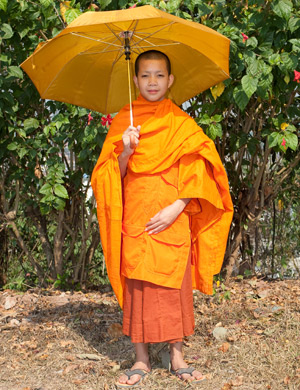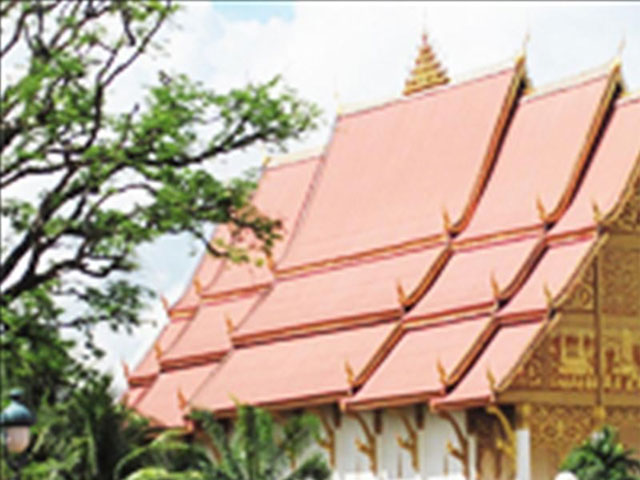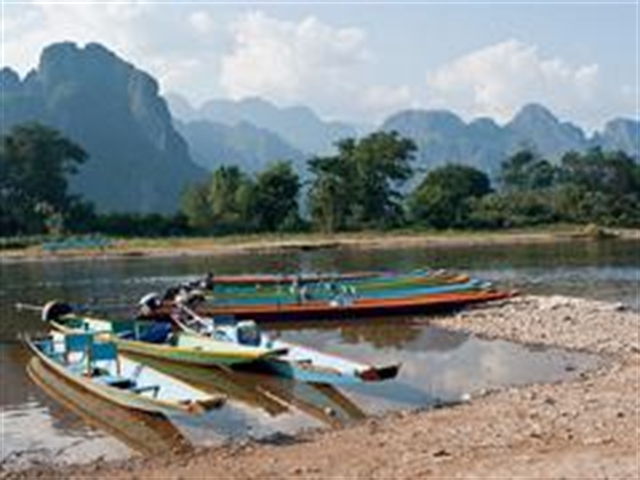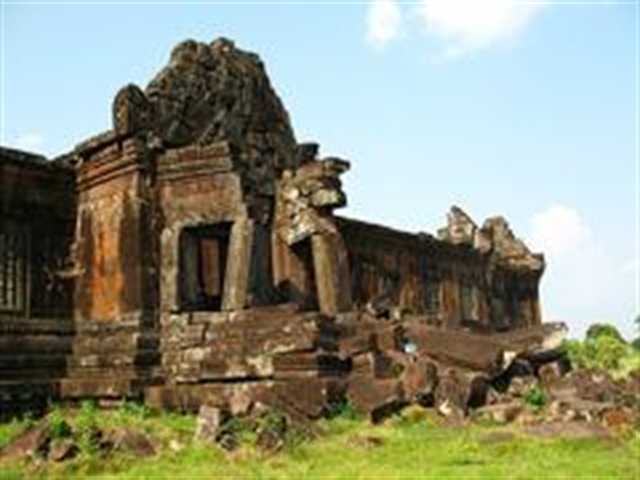 Landlocked and to some extent ‘culture-locked’, Laos possesses both Southeast Asia’s most pristine environment and possibly its most culturally intact heritage.
Landlocked and to some extent ‘culture-locked’, Laos possesses both Southeast Asia’s most pristine environment and possibly its most culturally intact heritage.
More than any other destination a visit to Laos provides the visitor with a sense of going back to a more relaxed time where the urgency of modern life is wonderfully absent.
Even in the capital Vientiane, life ambles along only a little faster than the languid Mekong river flows by the city’s charming riverfront.
In the historic royal city of Luang Prabang – a Unesco World Heritage site – hundreds of monks in saffron robes glide between centuries old temples unperturbed by the growing number of visitors gazing on in silence at a scene they thought only existed in films.
Luxurious boutique hotels in Luang Prabang serve exquisite food in historically preserved settings, drawing on French and local culinary traditions.
Beyond the cities visitors can discover the haunting Plain of Jars and the majestic Four Thousand Islands (Si Phan Don) where the Mekong river expands and its waters gather pace.
For the more intrepid traveller more active, but no less rare, experiences of tropical adventure can be had in jungles seemingly untouched by the passage of time.
In fact wherever you go in Laos there is a sense that this chapter in its history where locals and foreigners can meet with such equanimity may not last long.
So visit now, for the unique appeal of Laos will soon reach far and wide and inevitably a rush of sightseers will impact what, for the moment, remains a most beguiling and inspiring land.

 |
CAPITAL CITY The capital city of the Lao People’s Democratic Republic (Lao PDR is the official name of Laos) is Vientiane. |
 |
SIZE Inland area: 236,800 Km2. |
 |
GEOGRAPHICAL SITUATION Located towards the east of the peninsula of what was known as Indochina with no access to the sea, Laos shares its borders with China to the North, Myanmar to the North-West, Thailand to the West, Cambodia to the South and Vietnam to the East. An estimated 70% of the total area is dominated by rugged mountains, dense jungle and plateau. Peaks rise from 1500 to 2500 m, the highest one being the Phu Bia at 2820 m. The Mekong River, which still remains the main transportation link, extends 1800 km. Areas cultivated are located along the Mekong plain, where half of the population is concentrated. |
 |
POPULATION Laos has 6.5 million inhabitants with an average density of 27 inhabitants/km2. 48% of the population is Lao, 14% tribal Thai, 13% Sino Tibetan (including the Hmong and Yao ethnic minorities), 24% Mon-Khmer and 1% Vietnamese and Chinese. There are actually a lot of different ethnic minorities groups (69) in Laos but most of them belong to the three main categories: The Lao Loum, the Lao Theung and the Lao Sung. 85% of the population lives in the countryside. The dominant religion is Buddhism (65% of the population). There is a small community of Catholics while the rest of the population is animist. |
 |
LANGUAGE The official language is Lao. In addition to the dialects of Lao, numerous closely related languages (or dialects, depending on the classification) are spoken throughout the Lao-speaking realm in Laos and Thailand, such as the Nyaw, Phu Thai, Saek, Lao Wieng, Tai Dam, Tai Daeng. |
 |
CURRENCY The official currency is the Lao Kip (L-KIP). US dollars or Thai Baht are accepted in the main cities as are Euros in banks and for payment in some hotels and restaurants in major cities. The exchange rate is US$ 1 = 8167 Laos KIP, and 1 Euro = 8751 Laos KIP (Exchange rate update in September 2015). Traveller’s cheques can be cashed only at major banks and usually incur a 2% to 5% transaction fee. Visa and Master cards are accepted now in most hotels in Vientiane and Luang Prabang, and in a few restaurants and shops in the main towns (Vientiane, Luang Prabang and Pakse), but can also be subject to 2% to 5% transaction fees. You can also get cash advances with your credit card either from ATMs or from foreign exchange offices (subject to 2% to 5% transaction fees). Depending on the country you are travelling from, the best advice is to bring either cash in USD or Euro. Note that exchange rates for small and big notes vary, so we would recommend you to bring some small notes in US dollars to cope with initial expenses on arrival then either 100 USD or 100 Euro bank notes. Be careful, banks and foreign exchange offices do not usually take old, scribbled or even stained bank notes. Please check opening hours, as some banks close at 4 pm. |
 |
CLIMATE Laos has a tropical monsoon climate with two seasons: dry from October to April and rainy from May to September. Temperatures vary according to altitude and can be very cold in mountainous areas from November to February.
|
 |
LOCAL TIME Laos is 7 hours ahead of Greenwich Mean Time. |
 |
ELECTRICITY In Laos electric current is 220V, but sockets are not always standard. Adapters can be found in local markets. Note that one third of the country has not yet connected to electricity. |
 |
WATER It is advisable not to drink water from the tap unless it is boiled properly. |
 |
TELECOMMUNICATIONS For mobile phone users: only a few international operators have an agreement with Lao operators, but you will be able to buy phone cards on the spot. However, please keep in mind that the GSM cover does not yet reach the remotest provinces. Note also that there are a number of Internet shops in most of the big cities, although the Internet connection is often quite slow. Overseas calls can be made in most Internet Shops. |
 |
HEALTH & MEDICAL FACILITIES No vaccination is required, but visitors are advised to receive inoculations against hepatitis A and B, typhoid, rabies and tetanus, and to check in advance whether anti malaria treatment is necessary depending on the region they travel to. Inoculation for yellow fever is not necessary although doctors still usually recommend it. Vientiane has good hospitals staffed with foreign medical personnel, while in Luang Prabang and Pakse there are only local medical staff. For life threatening injuries it is advisable to be evacuated to Bangkok or Singapore and we strongly recommend that you arrange medical travel insurance. |
 |
TRANSPORTATION There are three international airports in Laos: Wattay in Vientiane located 15 minutes from the town centre, Luang Prabang in the North, 10 minutes from the heart of the historic quarter, and Pakse in the South located 10 minutes from the town centre. Road networks have improved but still need to be upgraded in some areas. By car or bus, it takes about 7-8 hours from Vientiane to reach Pakse and 8-9 hours from Vientiane to get to Luang Prabang. |
 |
DRIVING In Laos, vehicles drive on the right side of the road. Owners of an International Driving license are allowed to drive a car. Renting a motorbike is possible but, for security reason, can be temporarily forbidden in some areas by the local police. |
 |
COOKING Traditional Laotian cuisine boasts over 350 specialities from different provinces. The most famous one is the Lap, a salad with thin slices of chicken, fish or pork. Meals are generally averagely spicy but make use of a wide array of interesting sauces. The main cities now offer an increasing selection of international restaurants. |
 |
SHOPPING Although Laos is still developing, you can find all kinds of products, including some imported from Thailand. There is however a strong tradition of cotton and silk weaving. Beautiful fabrics and manufactured products can be found. Prices displayed are usually fixed, but in other cases do not hesitate to bargain. |
 |
TIPPING Tipping is not mandatory although it is appreciated. Note that prices in hotels and restaurants usually include 10% for VAT. |
 |
ACCESS Please find below a list of carriers offering services into Laos:
– Bangkok Airways Note that the main hub for connecting flights is Bangkok. |
 |
VISA AND PASSPORT A visa is compulsory to enter Laos. To obtain a visa you must first ensure your passport will be valid for at least 6 months after your return date. Citizens of Luxembourg and Switzerland do not need a visa if the length of their stay does not exceed 14 days. There are 2 options at the moment to obtain a visa for Laos: – For USA, Canada, Australia, New Zealand, E.U and Swiss citizens visas can be acquired either directly or through your travel agency at Laotian Embassies and Consulates. – You can obtain your visa on arrival at the international checkpoints of Wattay International Airport in Vientiane, Luang Prabang or Pakse International Airports, at the Vietnam-Laos border checkpoint on national road 8 (Namphao) near Vinh (Vietnam) and on national road 9 (Densavanh) in front of Lao Bao (Vietnam), as well as the Thai-Laos border checkpoints at the Friendship Bridge in Vientiane (in front of Nongkhai), Vangtau close to Pakse (in front of Chongmek) and Houeixay (in front of Chiangkhong). At the China-Laos border you can obtain your visa at the checkpoint of Boten, in front of Mengla (Yunnan province). Be careful, the checkpoint of Veunkham between Laos and Cambodia cannot deliver visas on arrival yet. Both a Cambodian and a Lao valid visa should therefore be in your possession before departure. |
 |
BEFORE GOING If you are travelling in the north or the centre from November to February warm clothes are recommended. Likewise warm clothes are necessary all year long in the northern provinces (Samnua, Phongsaly, Luang Nam Tha, Oudomxay, Luang Prabang and Xieng Khouang). In the south, light clothing is a must all year long except in Paksong (Salavan Province). We also recommend you bring along mosquito repellent and high factor sun block, a cap or a hat, sunglasses, a raincoat and a small bag to carry a few things in case you have to leave your big suitcases at the hotel for a few days. A torch may be useful depending on your itinerary. Laos is a predominantly Buddhist country. So you should pay attention to what you are wearing: avoid short and bare shoulder cloths when you visit temples or pagodas and for footwear slip-on shoes or sandals are the most common and conveninent. |

VIENTIANE
Vientiane is the capital of Laos and the name is thought to have two possible derivations: ‘the city of sandalwood’ or ‘the city of the moon’. Either way with just over half a million residents, it is the smallest capital city on South East Asia and possesses considerable charm. Located on the banks of the Mekong River, the city offers a mix of ancient gilded Buddhist temples, French colonial architecture and excellent strolling opportunities along it’s peaceful river front. An evening drink watching the sunset over the water is a must.

VANG VIENG
Formerly a pit stop between Vientiane and Luang Prabang, now Vang Vieng has become a destination for those keen to enjoy adventure activities such as kayaking, caving and rock climbing. The main attraction is the spectacular landscape and towering limestone rock formations riddled with caves, although the town is popular with backpackers for its river tubing and social cafes and bars.

LUANG PRABANG
Once the royal seat of the ‘land of thousand elephants’ as the Lan Xang Kingdom was known, Luang Prabang is located at the confluence of the Mekong and Nam Khan Rivers. The elegant tranquility of this charming town was described as an “outstanding example of the fusion of traditional architecture and Lao urban structures with those built by the European colonial authorities in the 19th and 20th centuries” when it received World Heritage Status in 1995 by UNESCO. With over 30 temples and pagodas within its jurisdiction it is best visited on foot or by bicycle. Several very stylish boutique hotels and excellent restaurants have emerged over recent years making this a truly delightful corner of the region to escape to.

PHONSAVAN, XIENG KHUANG (PLAIN OF JARS)
Xieng Kuang is the gateway to the mysterious Plain Of Jars, where jars of all sizes lie scattered over several sites across a slightly eerie plain. Possibly some sort of necropolis, or just simple rice wine containers, nobody really knows the origin or purpose of these stone jars, which are several thousand years old and weigh up to 3 tons each. Between the three sites open to visitors Hmong, Tai Dam and Khmu villages can be found and gentle hills and fragrant pine trees surround the new provincial capital of Xieng Khouang, Phonesavanh.

PAKSE AND CHAMPASSAK PROVINCE
Located in Champassak Province in southern Laos, Pakse is the second largest town of Laos. The primary attraction in Pakse is the Khmer archeological ruin of Wat Phou a Khmer temple dating from the 8-11th centuries and classified as a World Heritage Site. It was built by the founder of the first Khmer empire, Jayavarman II. Other attractions in the Champasak region include the 4,000 islands of Si Phan Don near the Cambodian border;
| Tour duration: | Tour starts at (city): |